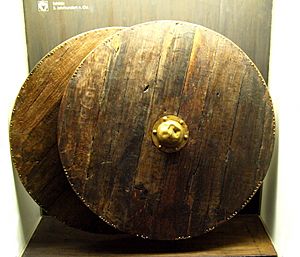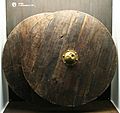Shield facts for kids
A shield is a tool or object used to block attacks or protect someone. It helps keep people safe from weapons or other dangers. Shields have been used for thousands of years by warriors, police, and even in sports.
Contents
The History of Shields
Shields are one of the oldest protective tools humans have used. Early shields were simple devices. They were made to stop hand weapons like swords or arrows. Over time, shields changed a lot. People made them from different materials, like animal hides or wood. Their size and weight also varied greatly depending on what they were used for.

Shields in the Middle Ages
During the Middle Ages, a popular type of shield was the Kite shield. This shield was shaped like a kite. It was long and narrow at the bottom, offering good protection for a knight's legs while riding a horse.
However, kite shields were often heavy. This made it hard for soldiers to move quickly on foot. Because of this, people started using smaller, lighter shields. One example was the Buckler. This was a small, round shield. It was much easier to carry and allowed soldiers to use two-handed weapons more freely.
Modern Shields Today
Even after gunpowder weapons became common, shields were still useful. Today, shields are used by police and military forces. They help protect officers and soldiers from bullets and other threats.

Modern shields are often made from advanced materials. These materials are very strong but also lightweight. Some shields even include electronics. Besides handheld shields, protective clothing like vests and special gloves or boots also act like shields. They protect different parts of the body.
Shields in the Future
In movies and science fiction, you often see ideas for future shields. These usually include force fields or energy shields. These imaginary shields can block attacks without being a physical object. They are a fun way to imagine how protection might change in the future.
Images for kids
-
Zulu chief Goza and two of his councillors in war-dress, all with Nguni shields, c.1870. The size of the shield on the chief's left arm denotes his status, and the white colour that he is a married man.
-
Wall painting depicting a Mycenaean Greek "figure eight", 15th century BC, National Archaeological Museum, Athens
-
Elaborate and sophisticated shields from the Philippines.
-
Greek soldiers of Greco-Persian Wars. Left: Greek slinger. Right: hoplites. Middle: hoplite's shield has a curtain which serves as a protection from arrows.
See also
 In Spanish: Escudo para niños
In Spanish: Escudo para niños







